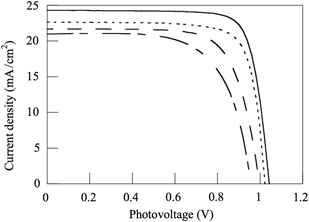Crossref Citations
This article has been cited by the following publications. This list is generated based on data provided by
Crossref.
Yang, Xichuan
Wang, Weihan
Zhang, Yanyun
and
Sun, Licheng
2018.
Improving the power conversion efficiency of solid state dye sensitized solar cells with a N-oxoammonium salt: 2,2,6,6-Tetramethyl-1-oxopiperidinebromide.
Solar Energy,
Vol. 170,
Issue. ,
p.
1001.
Okada, Wataru
Suga, Takeo
Oyaizu, Kenichi
Segawa, Hiroshi
and
Nishide, Hiroyuki
2019.
Perovskite/TiO2 Interface Passivation Using Poly(vinylcarbazole) and Fullerene for the Photovoltaic Conversion Efficiency of 21%.
ACS Applied Energy Materials,
Vol. 2,
Issue. 4,
p.
2848.
Oka, Kouki
Strietzel, Christian
Emanuelsson, Rikard
Nishide, Hiroyuki
Oyaizu, Kenichi
Strømme, Maria
and
Sjödin, Martin
2020.
Conducting Redox Polymer as a Robust Organic Electrode‐Active Material in Acidic Aqueous Electrolyte towards Polymer–Air Secondary Batteries.
ChemSusChem,
Vol. 13,
Issue. 9,
p.
2280.
Tsarev, Sergey
Kraevaya, Olga A.
Luchkin, Sergey Yu.
Stevenson, Keith J.
and
Troshin, Pavel A.
2020.
TEMPOL-promoted oxygen doping of a polytriarylamine hole-transport layer for efficient and stable lead halide perovskite solar cells.
Journal of Materials Chemistry C,
Vol. 8,
Issue. 7,
p.
2419.
Liang, Yuanying
Tang, Haoran
Zhang, Chunyang
Liu, Chunchen
Lan, Linfeng
and
Huang, Fei
2022.
Synergistic Effect of Oxoammonium Salt and Its Counterions for Fabricating Organic Electrochemical Transistors with Low Power Consumption.
ACS Applied Materials & Interfaces,
Vol. 14,
Issue. 45,
p.
51165.
Lin, Kun
Afzal, Shahzad
Xu, Liheng
Ding, Tao
Li, Feng
and
Zhang, Ming
2023.
Heterogeneous photo-Fenton degradation of acid orange 7 activated by red mud biochar under visible light irradiation.
Environmental Pollution,
Vol. 327,
Issue. ,
p.
121454.
Hiejima, Toshihiro
and
Kaneko, Junpei
2023.
Effects of Shear Stress on Antiferromagnetic Interactions within Nitroxide Dimers in Spin-Labeled Polypeptides and Their Conformational Analyses.
Macromolecules,
Vol. 56,
Issue. 23,
p.
9466.
Hatakeyama-Sato, Kan
and
Oyaizu, Kenichi
2023.
Redox: Organic Robust Radicals and Their Polymers for Energy Conversion/Storage Devices.
Chemical Reviews,
Vol. 123,
Issue. 19,
p.
11336.
Oyaizu, Kenichi
2024.
Reversible and high-density energy storage with polymers populated with bistable redox sites.
Polymer Journal,
Vol. 56,
Issue. 3,
p.
127.





